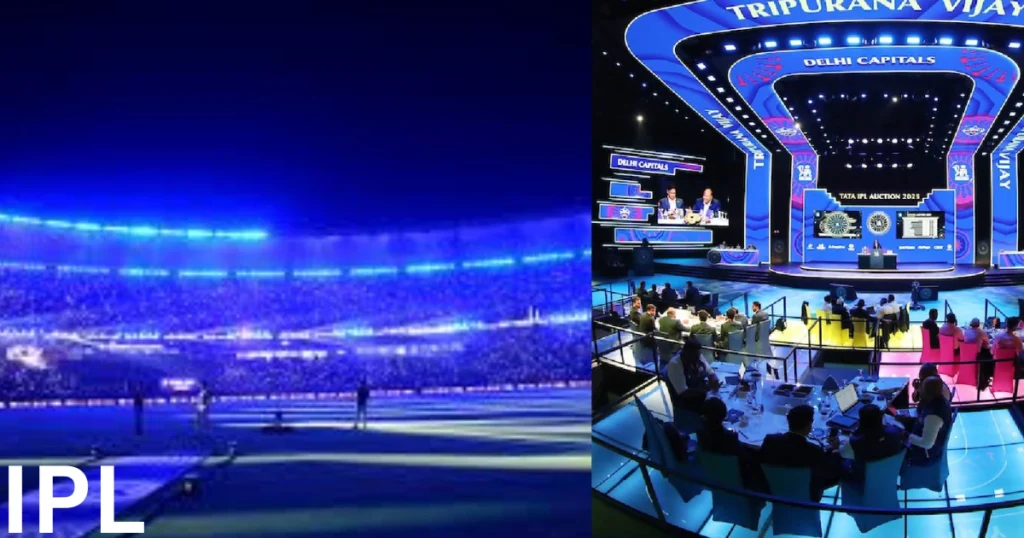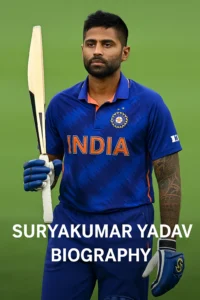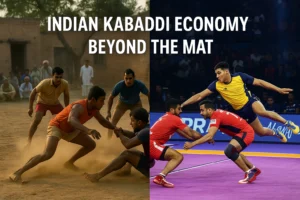The IPL Economy: How Cricket Became India’s Most Profitable Industry

A juxtaposition of the electric atmosphere in an IPL stadium and the high-stakes auction room highlights how the IPL economy blends entertainment and enterprise.
By Somya Prabhat | newslyy.com
Table of Contents
It started with a six. Not just on the field, but in boardrooms, on stock charts, and in the pockets of nearly every stakeholder in Indian entertainment. The IPL economy—once dismissed as a marketing gimmick—has become one of India’s most powerful financial engines. From media rights and sponsorships to fantasy leagues and fan-driven revenue streams, the Indian Premier League has transformed cricket into the most profitable industry in the country.
But how did a seasonal cricket tournament come to outperform Bollywood blockbusters, venture capital-backed unicorns, and even global tech players? The answer lies at the intersection of entertainment, economics, and timing.
A Billion-Dollar Business Born in a Recession
When the IPL launched in 2008, India was still reeling from the global financial crisis. Consumer confidence was low, brands were pulling back on ad spend, and conventional cricket had taken a reputational hit after India’s early exit from the 2007 World Cup. Yet in that uncertainty, the BCCI saw an opportunity.
Modeled loosely after American sports franchises like the NBA and NFL, the IPL’s innovation was not just on the pitch—it was structural. Private ownership, team branding, player auctions, and prime-time television deals turned what was traditionally a slow-paced, daylong affair into a three-hour money magnet.
And it worked. According to a report by Brand Finance, the IPL’s brand value crossed ₹92,500 crore (~$11 billion) in 2023, growing at a rate faster than any traditional industry over the same period.
The IPL Economy: A Self-Sustaining Flywheel
At the heart of the IPL economy is a multi-revenue flywheel that few industries can replicate. Broadcasters pay billions for rights. Franchises earn from those rights, plus ticket sales, merchandise, and sponsorships. Players become celebrities. Advertisers access a live audience of hundreds of millions. Everyone wins.
Consider this: Viacom18 paid ₹23,758 crore for the 2023–2027 IPL digital streaming rights. That’s over ₹46 crore per match, placing IPL behind only the NFL in per-match value. Television rights, owned by Disney Star, were sold for an additional ₹23,575 crore. Combined, these numbers dwarf the annual revenue of many Fortune 500 Indian companies.
Compare that with India’s film industry—long considered the crown jewel of desi entertainment. Bollywood’s total revenue in 2023? An estimated ₹15,000 crore. The IPL’s? More than ₹25,000 crore in direct and ancillary revenues, according to Redseer Consulting. Read the full report.
Cricket as Capitalism: How India Fell in Love with the Model
Part of the IPL’s meteoric rise has less to do with cricket and more to do with how Indians consume entertainment. India is mobile-first, digitally active, and emotionally invested in its sports heroes. The league harnessed this attention into monetizable moments—from fantasy apps like Dream11 to regional-language streaming on JioCinema, which broke global records with 3.2 crore concurrent viewers during the 2023 final.
More importantly, the IPL democratized cricket. Suddenly, cities like Lucknow and Ahmedabad—long ignored in elite sporting circuits—had teams, stadiums, and billion-dollar franchises. The expansion created new local markets, new job opportunities, and new revenue streams across logistics, advertising, tourism, and media.
See our coverage of How WPL is Changing the Landscape for Women’s Sports in India.
Global Impact: Exporting the IPL Blueprint
What began as an Indian experiment is now being replicated across the world. The UAE’s ILT20, South Africa’s SA20, and the new U.S.-based Major League Cricket all draw heavily from the IPL format. In a telling twist, many IPL franchises now co-own teams in these international leagues, effectively exporting their business model across borders.
This global footprint is unique. While the NBA and English Premier League are consumed globally, they aren’t owned globally. The IPL, on the other hand, is fast becoming India’s most valuable export in soft power—outpacing even Bollywood in reach and influence.
And it’s not just about money. The IPL has catalyzed advancements in broadcasting technology, AI-powered analytics for player performance, and real-time fan engagement tools. It’s also created a niche job market for analysts, content creators, and sports marketers—industries that didn’t exist in this form a decade ago.
What Makes the IPL Economy So Resilient?
The remarkable thing about the IPL economy is its resistance to macroeconomic shocks. During COVID-19, when cinemas shut and ad budgets slashed, the IPL adapted—hosting matches in bio-bubbles, shifting to digital-first strategies, and even increasing ad revenue through programmatic buying.
It’s this resilience, combined with an ever-growing viewer base, that makes the IPL economy stand apart. The league now commands nearly 60% of India’s annual sports advertising spend, according to GroupM. For every ₹10 spent on sports sponsorship, ₹6 goes to the IPL.
No startup, no government-backed project, no traditional media house enjoys that kind of concentration and security.
You can also read Indian Kabaddi Economy: From Mud Fields to Multicrore Dreams
A Future on the Stock Market?
As the league matures, there’s growing chatter about a possible IPO—either of the IPL itself or of a holding company encompassing multiple franchises. Should that happen, cricket might become India’s first publicly traded sport. It would mark a radical shift: from bats and balls to balance sheets and shareholder meetings.
What might that mean? Greater transparency, quarterly earnings calls, institutional investors—and perhaps a global ETF backed by Indian cricket. Unreal? Maybe. But so was the idea of a T20 league raking in ₹100 crore per match.
Final Over: Beyond Sport, Into Structure
The IPL economy is not merely a success story in sports. It is a blueprint for scalable, sustainable, culturally-rooted capitalism. In a nation with complex regulation, infrastructure bottlenecks, and a fragmented consumer market, the IPL stitched together something rare: trust, returns, and fandom.
It has become more than a summer tournament. It’s now an institution—one that has outpaced conventional industries in both speed and scale.
The question isn’t whether the IPL economy will grow. The question is—how far can it go before someone else tries to buy the whole league?






1 thought on “The IPL Economy: How Cricket Became India’s Most Profitable Industry”